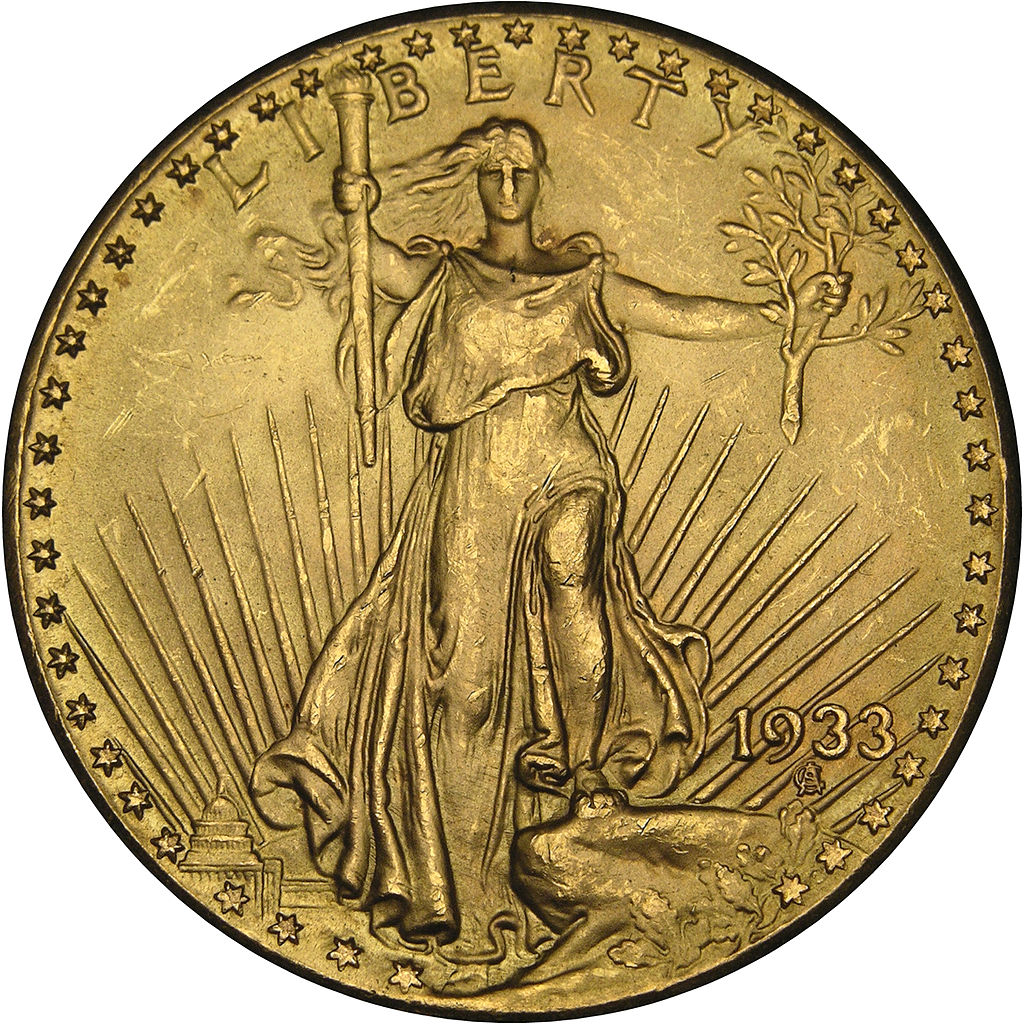 Since there is only one in existence able to be privately and legally owned, the 1933 Double Eagle is considered one of the rarest coins in the world today. The Official Red Book, A Guide of United States Coins by R.S. Yeoman states that 445,500 Double Eagle gold coins were produced in 1933 at the Philadelphia Mint. However, before they were officially released, an executive order by Franklin D. Roosevelt was issued and the gold coins never made it into circulation. The economic crisis during the 1930’s, which declared gold coins to no longer be legal tender of the United States, resulted in most of the 1933 Double Eagle coins to be melted down.
Since there is only one in existence able to be privately and legally owned, the 1933 Double Eagle is considered one of the rarest coins in the world today. The Official Red Book, A Guide of United States Coins by R.S. Yeoman states that 445,500 Double Eagle gold coins were produced in 1933 at the Philadelphia Mint. However, before they were officially released, an executive order by Franklin D. Roosevelt was issued and the gold coins never made it into circulation. The economic crisis during the 1930’s, which declared gold coins to no longer be legal tender of the United States, resulted in most of the 1933 Double Eagle coins to be melted down.
Smithsonian Institution’s 1933 Double Eagles
Two of 1933 Double Eagles were gifted to the Smithsonian Institution. These were believed to be the only two left in existence until rumors and claims of other 1933 Double Eagles began to surface. The U.S. Government soon realized a few of these 1933 gold coins were illegally taken from the mint before they were destroyed. Nine of the stolen coins were recovered by the U.S. Government by the year 1952.
In 2003, another ten 1933 stolen Double Eagles appeared. The coins were in possession of the Langbord family of Philadelphia. While trying to authenticate the ten coins, the Langbord family lost possession of the coins to the United States. They were considered illegally obtained, and therefore the property of the United States. In an effort to have the coins returned to them, the Langbord family went to court. In July of 2011, the court’s decision stated the ten Double Eagles would remain with the United States. Although it is said the case will be appealed, this decision was affirmed once again in August 2012.
Following the verdict, it was clear to collectors that any 1933 Double Eagles found circulating were considered illegal, and would need to be returned to the United States Government. There is one exception, though, and it is the only 1933 Double Eagle which is legal to own.
The Farouk 1933 Double Eagle
In 1944 King Farouk of Egypt obtained an export license for a 1933 Double Eagle. After realizing they had mistakenly granted a license for one of the stolen 1933 Double Eagles, the United States Government requested for the coin to be returned. It never was. Then in 1954 when King Farouk’s coin collection was set for auction, the United States requested again for the return of the coin. Once again the coin was not returned and went missing for the next 42 years.
In 1996 it is believed the Farouk 1933 Double Eagle resurfaced. A London dealer, Stephen Fenton, along with Jay Parrino, a U.S. dealer, were discovered to have in their possession a 1933 Double Eagle. The coin was confiscated and they both were arrested in New York. The charges were later dropped when Fenton claimed to have purchased the coin from the coin collection of King Farouk and demanded the coin back.
In 2001 an out of court decision on the coin was made. The United States would officially legalize, monetize, and issue the coin. The coin would be auctioned off to a highest bidder and the earnings would be split between Fenton and the U.S. Government.
Collecting Rare Coins
Collectors of rare coins most certainly watched and listened to the bidding of the 1933 Double Eagle coin on July 30th, 2002. The coin, because it is the only one of its kind able to be privately and legally owned, brought the record price of 7,590,020 dollars. The highest bidder remains anonymous.
Coins of all types have interesting histories associated with them. Collecting rare coins can be especially intriguing because of the reasons which make them rare. In the case of the 1933 Double Eagle, the story surrounding the coin is an exceptional and adventurous one.


Pingback: The 1913 Liberty Head Nickels: Five Treasures » Mysterious Writings
Gold! There is gold to be found within your own mind.
Read and use “Novanetics” by Douglas Myrick.
A happier, healthier life is waiting.
http://novanetics.com
very interesting
Just digging around, jenny, and I found this hidden gem. Amazing!